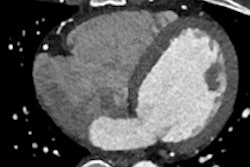Radiation doses to sensitive brain regions are significantly reduced when iterative reconstruction is used in pediatric brain CT, according to a presentation at this week's American Roentgen Ray Society (ARRS) meeting in San Diego.
In a study of 451 patients, the use of adaptive statistical iterative reconstruction (ASIR, GE Healthcare) reduced dose to the salivary glands and brain by about one-fourth compared to non-ASIR exams, though the researchers found no significant difference in organ dose distribution for other structures.
The group from Massachusetts General Hospital and Harvard Medical School aimed to determine what scanner- and patient-related factors affect overall and organ-based radiation dose in pediatric head CT examinations reconstructed with and without iterative reconstruction. They scanned 451 consecutive patients younger than 19 (mean age, 11 ± 7 years) from 2011 to 2013.
Three GE scanners were used in the study: a 64-detector-row LightSpeed VCT system equipped with ASIR, a 64-detector-row Discovery 750 HD scanner with ASIR, and a LightSpeed Pro 16-detector-row scanner without ASIR. Doses were retrieved using dose-monitoring software (Radimetrics).
The study team recorded dose metrics including size-specific dose estimate (SSDE), CT dose index volume (CTDIvol), dose-length product (DLP), and estimated effective dose (EED) for each exam. The cohort was divided into five subgroups by age and into two effective diameter subgroups based on median diameter. Mean radiation doses were compared across age subgroups, gender, effective diameter subgroups, and whether or not the scanner used ASIR.
Exams reconstructed with ASIR had significantly lower dose (SSDE, 22 ± 13 mGy) than those performed without ASIR (29 ± 17 mGy), according to presenter Ranish Deedar Ali Khawaja, a research fellow at Harvard Medical School, and colleagues. In addition to the iterative reconstruction algorithm, patient age and effective body diameter significantly affected dose.
Overall, mean CTDIvol was 23 ± 14 mGy, DLP was 430 ± 289 mGy-cm, SSDE was 22 ± 13 mGy, and EED was 1.6 ± 1.5 mSv.
The five areas with the highest radiation doses were the salivary glands, brain, eye lenses, skeleton, and thyroid gland. ASIR's dose reductions were statistically significant for the salivary glands and brain compared to non-ASIR CT exams (p = 0.03). However, differences were not significant for the lenses, skeleton, or thyroid (p = 0.1).
Mean SSDE differed significantly across the age subgroups, from infants (14 ± 8 mGy) to toddlers (16 ± 8 mGy), children (15 ± 9 mGy), older children (19 ± 9 mGy), and adolescents (30 ± 14 mGy). There was no statistically significant difference in dose between boys (22 ± 13 mGy) and girls (22 ± 13 mGy).
"In addition to reconstruction algorithm, patient age and effective body diameter significantly affected the doses," the group concluded. "ASIR significantly reduces the radiation dose [mean reduction of approximately 24%] in pediatric head CT, with significant reduction in dose output to brain and salivary glands."



















